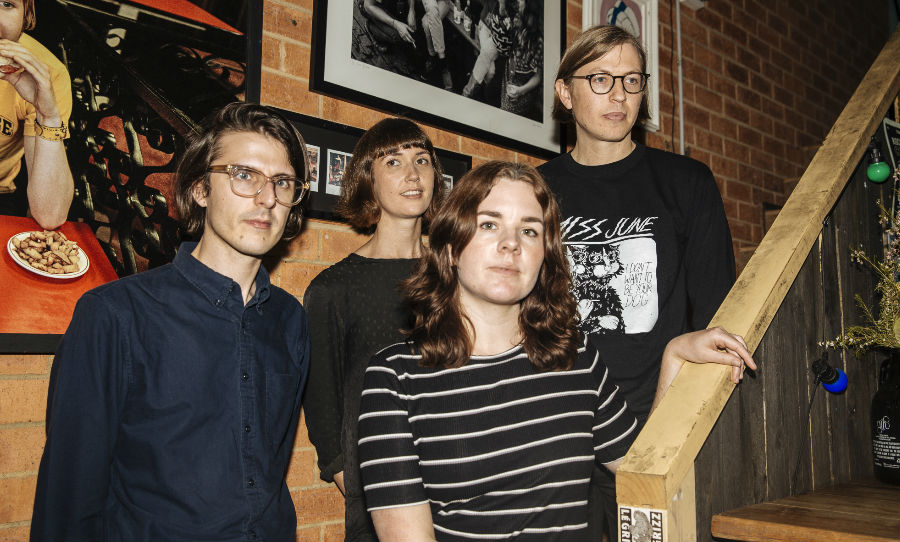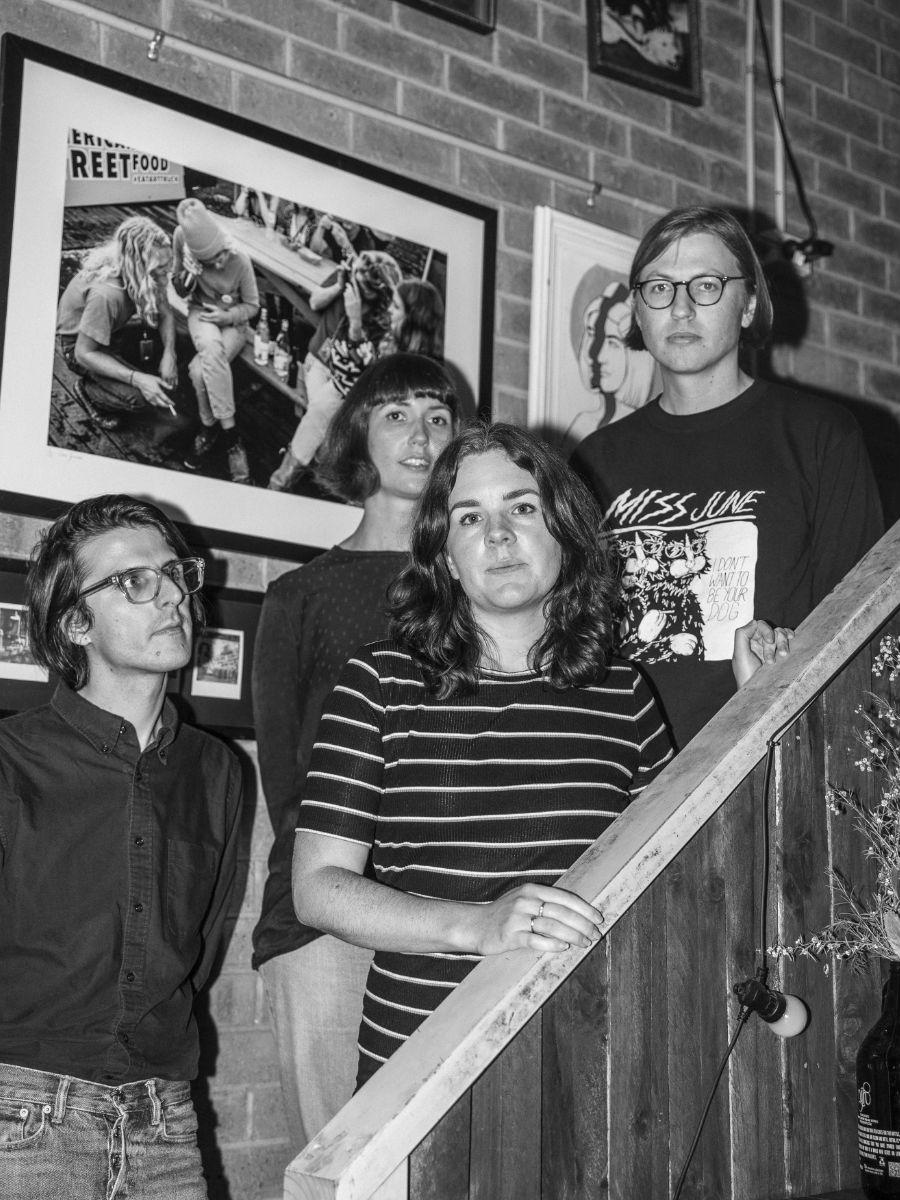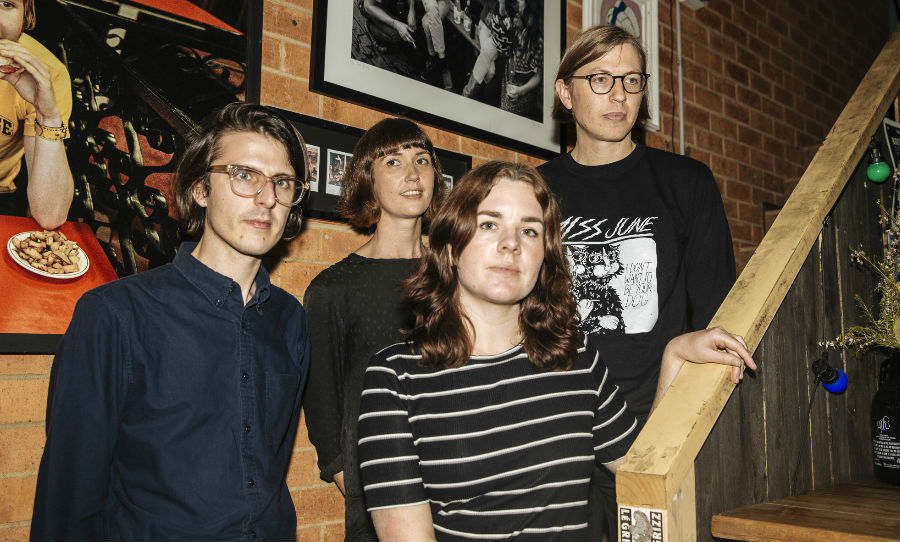Things have been changing for Tiny Ruins. What started as the solo folk project of Hollie Fullbrook, the band now operate as a four-piece, and for their third album, they’ve decided to go bolder, more experimental.
So before Olympic Girls drops on February 1st, we caught up with Fullbrook to chat about their new sound, giving up control, accepting her role as a ‘frontperson’, and the visual side of music.

“We decided to go more experimental”: We caught up with Tiny Ruins frontwoman Hollie Fullbrook to chat about their ‘bold’ third album.
HAPPY: It’s been four years since you released Brightly Painted One, and you’ve now completed your next record Olympic Girls. What did the writing of this new album look like? Did you start piecing it together straight after Brightly Painted One? Or did you let things sit for a while before getting into it?
HOLLIE: I started writing the songs on this one while we were touring Brightly Painted One. So I started writing while we were on tour in 2014, and continued writing up until 2015, and then we started recording in 2016. I was still writing, actually, all through the recording process. We were recording for about a year and as we were recording I’d write new songs. So it was a long process. It’s been a while. I did release an EP in the middle of it all. But in terms of working towards a large project like an album, it’s been a little while.
HAPPY: After an album like Brightly Painted One, which was quite successful, are there any nerves or apprehensions about releasing a follow-up?
HOLLIE: No, I don’t think I was nervous. We toured Brightly Painted One really hard, so we were on the road for about six to nine months. I was really burnt out by that. The album was successful, but not successful to the level where we had a tour manager or anything. We were doing a lot of it ourselves – we still are. So I would say that I was burnt out more than anything after releasing that album. It took me a while to get out of the mode of touring and get back into a creative zone. I remember in 2015, I was trying really hard to write a lot of songs because I knew the pressure was on to get a collection of songs together quickly. That’s what everyone wants. But I struggled that year to finish any songs. Looking back, all of those songs came together, but at the time I felt like I was in a real rut. Serious writer’s block. I didn’t feel inspired by anything. Towards the end of that year, I thought “oh wait, these songs actually are okay, they’re good enough.” Some of the songs on the album took no time at all to write, and then others took a really long time.

HAPPY: Do you feel like putting that kind of pressure on yourself resulted in strong songwriting, or do you prefer to not have that pressure?
HOLLIE: I think there’s always quite a lot of pressure that I put on myself, just from being a highly critical person. It’s a blessing and a curse. It means that when I do finally finish a song, I’ve really put it through its paces. I’ve pushed and tried to get something that I’m happy with. But it also can hold you back. I wasn’t worrying how people would perceive the songs or anything, but I did want to grow from Brightly Painted One. I didn’t want to write the same album again, and I didn’t want to rest on the laurels of writing folk songs. One of the first songs that I wrote on Olympic Girls is a song called One Million Flowers. It’s a song with a lot of different tempo shifts and sections. It’s just a lot more experimental. I love my earlier songs, but with this album, I wanted to write in a more experimental way. I don’t know if I’m making any sense. I don’t think it was outside pressure, but rather inside pressure to branch outwards. But in the end, I think it paid off because we have branched out from the last album.
HAPPY: I understand that in the four years since Brightly Painted One, you started listening to a lot of heavier music.
HOLLIE: Yeah.
HAPPY: What effect do you think this had on your new music? If anything…
HOLLIE: There was definitely a period of time when, as I said, I felt quite uninspired by a lot of things. I felt quite numb towards a lot of things. There are a few little festivals we have in New Zealand, and I remember having a few experiences at these festivals seeing really heavy bands. There’s a New Zealand band called HEX for example. Mainly seeing bands live, and comparing it to our own live performance. I really wanted to be bigger and express more. I think if you are in a numb state, you need something a bit stronger and a bit more powerful for it to get through to you. I remember listening to a lot of older punk that I hadn’t really listened to when I was growing up. I grew up listening to really quiet folk music. So I guess that was a period of my life where I really wanted to obliterate my ears.
HAPPY: You’ve mentioned before that you gave up a lot of control on this album. Was this a matter of being more collaborative with other band members? Or Just letting songs grow in their own natural way?
HOLLIE: Yeah, kind of both. I was reaching a point in my life where I was prepared for an album to take as long as it needed it to. I think a lot of bands have huge pressure on them to write and record really quickly, and that can produce amazing results. But there is something to just saying “you know what, this is going to take a while, I’m not going to try and force this.” We accepted that we all have other jobs and we’re all older, and we have more commitments and relationships. Your life isn’t just touring and music. There are lots of other things to consider. So it was about practically letting go and saying “let’s take our time with this.” We had the luxury of recording in our rehearsal space, because Tom who plays in the band and produced the album, owns a little recording space where we recorded and rehearsed. We didn’t have the pressure of being in a studio. And as you said, allowing more collaboration from bandmates. I’ve always played with such great musicians, that I’ve never needed to direct anyone. But with this album, before we recorded anything, we said: “how do we want this to be different from the last album?” We decided not to hold back, to not be too restrained. It was about going further. So it took a little bit of letting go on my part. But that’s a good thing.
HAPPY: So you made a conscious decision to do this?
HOLLIE: Yeah it was quite conscious. Tom also produced Brightly Painted One, and he knows the ins-and-outs of how I work. I said to him that there were some moments on Brightly Painted One where I wish we had gone wilder, a little less restrained. So we decided to go more experimental and bigger. One Million Flowers was kind of the first song that dictated that. It was this big, bold, kind of psychedelic song – so from that point onwards, we went that direction.

HAPPY: Something that I find really interesting about your music is that you’ve always used album art as a way to depict what’s in the album musically.
HOLLIE: Hmm. That’s cool to hear.
HAPPY: Even with your videos, the visual element always seems very closely aligned with the music. So firstly, is this a consideration for you?
HOLLIE: Yeah, definitely. The art has to be right. It has to feel right. In the past, I’ve been really reluctant to have my face on any of my stuff. I said that to someone the other day, and we’ve got this animated illustration of my face on all our t-shirts at the moment. So they were like “oh sure.” I’m slowly being a little more forward with being the front person, I guess. I don’t mind as much having a connection between the music and one singular person. I never used to like that. I just wanted people to listen to the music, and I didn’t really want to be at the front of it. It’s not really to do with confidence, but not wanting it to distract from the music. But I was a lot younger when I thought that. Now I understand more about what people want. People generally connect to the person who’s writing the songs. But with this album cover, I’m not on it. I’m away in the background reading a book. Cass took the photograph on an old camera of hers. We actually tried to recreate it, because the lighting was so low that it was really grainy. So we tried to get a better quality shot. We went back to that house in Wellington, and we tried to recreate it with the same breakfast stuff on the table. But it just didn’t work. It wasn’t the same.
HAPPY: So the one you used is the original photo?
HOLLIE: Yeah that’s the original photo. But yeah, the visual side of things is really important. Music videos are another thing that I’ve shied away from for a long time. I’ve always avoided making them, until this year. It’s been interesting. I didn’t dislike it as much as I thought I would. I kind of see now how making a music video can be fulfilling creative pursuit. Whereas I used to feel annoyed at how we were expected to make this film as well as the music. There’s a lot about the music industry that feels like they don’t actually want music, they just want photos and videos, and visual content. I find that frustrating sometimes. But it turned out to be really fun.
HAPPY: It’s interesting because most people I talk to think that the music and visuals are inextricable from one another. I’ve never met someone who’s frustrated by it.
HOLLIE: Oh really? That’s funny. I think it depends what kind of creative person you are. Some songwriters would love the idea of coming up with a music video. And a lot of the time, songwriters love film. It’s just one of things like “I’m a musician. I’m a songwriter. This isn’t what I signed up for.” Now I sound like I’m whining. It’s just a really different creative process. Some people find it really exciting, but I just find it stressful. It’s a lot of money as well. I look at it like, I could spend that money on making another album. My whole thing is to try and look after the musical side. Once you spread yourself across all these different mediums to try and reach your audience, it can dilute your attention away from the whole reason you’re doing it in the first place. At least now I’m trying to do the videos. But it’s not a natural thing. I’m still a nervous wreck before doing it.
HAPPY: Well they all turned out great.
HOLLIE: Thank you.
HAPPY: But back to the new album. How do you think the album’s cover art reflects the music that’s inside? If at all…
HOLLIE: Yeah that’s a good question. Well, the photo’s been manipulated a little bit. Because it was this grainy old film photo, we cleaned it up quite a bit. We lightened it so you could see what’s in the room. Then the colours have been intensified, so it’s almost got a technicolour aspect to it. And that’s one of the feelings I wanted to have in the music. I hate over-using the word ‘psychedelic’, but I wanted the album to have a heightened sonic palette, I guess. Hopefully, some people will listen to it with good headphones and pick up some things you can’t really pick up with shitty speakers. But yeah, the idea was that it was a colourful, exuberant album – almost celebrating life. I wrote most of the songs when I was in a really happy state. Once I broke through the numb, uninspired state, I looked through to things that I found really extreme. I looked through a big book of Van Gough paintings, with really broad strokes and really bright colours. That was the feeling I wanted to have in the songs. Another influence on the songs was Walt Whitman’s Leaves Of Grass. I was kind of dipping in and out of that as I was writing the songs. The photo was taken while we were waiting for breakfast from our friend Dave. we’d just played a show, and we woke up on this beautiful sunny morning. So there’s a little bit of this hazy, dreamy look. But there’s also this real sense of colour. Also, I liked the idea of it being an inside interior, but you’re drawn to the outside external stuff.
HAPPY: I must say, it looked like a really nice house.
HOLLIE: It was really nice. It’s got such a great view. My mate Dave, who’s a builder, he flats there. We always stay with him when we’re in Wellington. We didn’t know it would end up on the album cover. And the guy who lives there is kind of freaking out because all these people are texting him like “hey, is this your house?”
Catch Tiny Ruins live at any of the following dates:
Sunday 28th April – Bendigo Autumn Music, Bendigo
Thursday 2nd May – Howler, Melbourne
Saturday 4th May – Jive Bar, Adelaide
Wednesday 8th May – Uni Bar, Wollongong
Thursday 9th May – Oxford Art Factory, Sydney
Friday 10th May – Black Bear Lodge, Brisbane
Saturday 11th May – Mojo’s, Fremantle
Olympic Girls is our February 1st.



